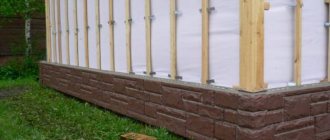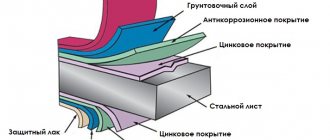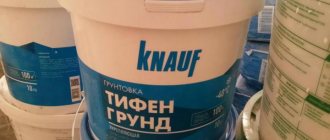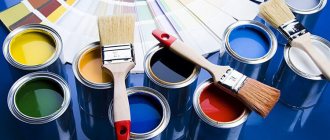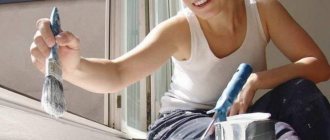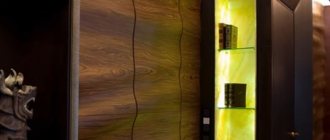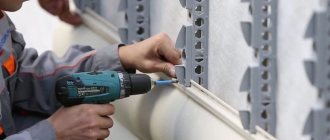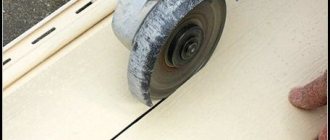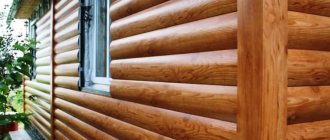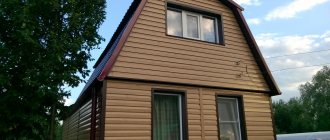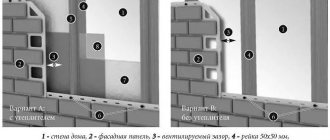Wanting to quickly and beautifully cover the facade of their home, private developers prefer siding. The finishing material is characterized by ease of installation, allows you to achieve effective and aesthetic results, equip a ventilated façade and save significant money. In addition, it can be used to disguise uneven and crooked sections of walls and other imperfections. The material is made in different types, one of which is metal siding under timber.
About metal siding
Steel (metal) siding belongs to the category of facing materials. Most often it is used to decorate the walls of residential and public buildings. The material, in the form of panels, is used in facade systems (ventilated facade technology). The physical parameters of metal siding can be described by the following provisions:
- Appearance . Products are manufactured in the form of profiled panels with a perforated edge intended for fastening. The surface of the panels is painted in any color or imitates a natural (for example, wooden) texture.
- Material . The panels have a multilayer structure and are made of hot-dip galvanized cold-rolled steel. A layer of primer is applied to the steel base, protected by zinc. Then the front side is covered with polymer, the back side with a layer of paint.
Close-up Source tr.decoratex.biz
- Profile . Metal siding manufacturers offer several shape options. Popular ones include: eco-beam siding (ship plank, the most common option), L-beam (imitation of double timber), eco-beam (timber siding that imitates the surface of a timber wall), metal blockhouse (siding with log-like geometry), Christmas tree - identical to lining . Vertical siding is mainly used for finishing industrial buildings.
- Polymer coating . The pattern, which replicates the wood texture, is applied using photo offset printing, which gives the panels a realistic look. The cladding so successfully imitates the geometry and color of wood that the difference is only visible upon closer inspection.
- Variety of textures . Manufacturers develop an original palette of colors for each profile: uniform or simulating various types of wood. You can choose not only classic options (pine, larch, cedar, walnut), but also, if the design requires, the colors of stained or bleached oak, cherry or rowan. The color scheme of some collections is complemented by a pattern simulating a stone or metal surface.
Samples of textures Source tr.decoratex.biz
See also: Catalog of companies that specialize in facade materials.
Types of imitation for timber
Imitation timber is a material for external and internal finishing of buildings, made from natural wood - mainly pine, spruce or larch.
In fact, this is a type of lining, assembled repeating the texture of the surface of a wall assembled from planed timber.
It is a flat board with beveled edges , having a groove on one side and a tenon on the other for consistent assembly.
On the reverse side there are longitudinal compensation grooves that equalize stress when gaining or releasing moisture, and also promote air movement .
Imitation timber is divided into grades according to the quality of the surface - the number of flaws per 1 linear meter, the number of knots, the presence of cracks, etc.
Basically, glued imitation timber is made, consisting of individual dies, spliced in the longitudinal direction into one panel of the required length .
IMPORTANT!
The wood is also intended for outdoor work, so it goes through a full drying cycle and is impregnated with compounds that protect against rotting and fire - antiseptics and fire retardants.
Based on quality, imitation timber is divided into groups:
- A (Extra) - the highest grade of panels , without knots (or a maximum of 3 small ingrown knots per panel), without surface flaws. The most expensive type;
- AB - transitional type between highest and first grade , there is minor surface damage, small knots;
- B - the presence of a small number of small irregularities, microcracks . More than 3 knots located on the front side of the panel are allowed;
- BC - transitional type between low and medium quality , the presence of falling out (dead) knots with a number of more than 3 per 1 linear meter. panels, there are non-critical chips or violations of the integrity of the tenon or groove;
- C - chips, falling knots or cracks are possible without affecting the performance of the material. Resin pockets are allowed.
Not allowed:
- Through fallen knots;
- Resin pockets wider than 8mm;
- Presence of wane on the front side;
- The presence of “fringe”, which is a consequence of poor-quality surface treatment.
The thickness of the panels ranges from 16 to 35 mm, the width is in the range of 110-190 mm.
Kinds
Pros and cons of metal siding
Metal siding is a popular building material due to the following advantages:
- Durability . The guaranteed service life of polymer-coated material is from 10 to 15 years. The actual (predicted) operating time is estimated at 40-50 years.
- Wide temperature range of use . Metal siding retains its properties at temperatures from -50 to +80°C.
- Physical parameters . The panels do not deform over time and are resistant to mechanical stress and the formation of chips and cracks. The material is environmentally friendly and non-flammable, resistant to temperature changes and corrosion.
- Fade resistant . Throughout the entire warranty period, the panels do not change their characteristics under the influence of solar ultraviolet radiation.
- Slight thermal expansion . The coefficient of thermal expansion is less than that of vinyl analogues.
- Design possibilities . A wide range of shades and textures allows you to choose metal siding for cladding a house in any architectural style.
Fragment of a facade with an additional element Source stroidomsait.ru
Professional builders note the following advantages of the material:
- Manufacturability . Siding panels can be installed year-round. The material is convenient to use for cladding facades with external insulation.
- Easy installation . The work is characterized by ease of assembly and minimal time expenditure.
- Light weight of panels . Finished cladding does not create excessive load on the walls of the house.
- Possibility of recovery . If the polymer coating has received minor damage (chips, scratches, abrasions), you can restore the original appearance by selecting paint from the catalog.
- Decent appearance of the facade . The panels are equipped with fastenings for hidden fixation; The finished facade made of metal siding does not require special care and maintenance.
Popular manufacturing companies
There are many siding manufacturers in the world.
The most famous manufacturers include:
- Mitten;
- Variform;
- Elixir;
- Vytes;
- Gentek;
- Kaycan;
- Foundry and many others.
From domestic:
- Dock;
- Grand Line.
The list of manufacturers can be continued for a long time, but there is little point in this, since all products on today’s market are of high quality, since they must meet certification requirements.
Little-known companies that are forced to save on production are of lower quality . It is better not to purchase such products, since with a very long service life of the cladding (50 years or more), the lack of a quality guarantee is not attractive.
One of the manufacturing companies
Video description
About finishing a house with metal siding in the following video:
In general, the practical material also has some disadvantages that you need to be aware of when choosing facade cladding. The disadvantages of the material are:
- Price . If you compare the prices of metal and vinyl siding under timber, the price of metal panels will be higher.
- Need for careful handling . This applies to both installation work and subsequent operation. If the polymer layer is damaged down to the metal, this may cause corrosion in the future. A strong blow to the surface will leave a dent (no marks are left on elastic vinyl siding).
- Rigidity . It is impossible to cover rounded façade elements with metal siding panels.
- High thermal conductivity . Like any metal, the material heats up in the sun, which is sometimes an obstacle to use.
Panel parameters Source montazh-zaborov.ru
General rules
- To prevent the panels from deforming due to temperature changes, make sure that the screws are not tightened by about 1-1.5 mm. In this case, they should be located exclusively in the center of the perforation in increments of 400 mm;
- We recommend that you start laying metal siding from the corner of the building. In this case, the first row should be attached to the first plank. And all other planks are mounted in the lock of the previous one. And so on until the end, after which the panels under the windows are cut out.
Let's sum it up
Thanks to their stunning imitation of natural wooden beams, the panels have become quite popular and in demand recently. Use our tips and you will turn your home into a cozy and attractive masterpiece of architecture.
Specifications
Metal siding has the following parameters and technical characteristics (average indicators are given, which may differ between different manufacturers):
- Dimensions. Many manufacturers make panels to order, according to the size of the house. The length range can vary from 0.5 to 8 m, installation width - from 22 to 36 cm, overall width - from 26 to 39 cm. Profile height can vary within 12-15 mm, metal thickness - from 0.5 to 1 .1 mm.
- Weight of 1 m2 of material. Steel siding - 5-6 kg, aluminum - 1.7-1.9 kg.
- Color spectrum. Determined by RAL and RR classifiers. The color range of metal siding has brighter and more saturated shades than its vinyl counterpart.
- Lock system. A common design that controls the evenness of joints is a latch lock. Some panels have an additional element of rigidity, which increases the reliability of fixation of the façade cladding in heavy winds.
- Protection. To reduce the likelihood of damage during storage and transportation, metal siding panels are stacked one-on-one and secured with stretch film.
Additional elements Source 100-dom.ru
- Equipment . To make the house cladding look neat, additional elements are used in the design of corners, window and door openings in addition to the main panels. These include corner, starting and finishing strips, slopes, soffits and other components.
Installation of vertical strips - corners and H-shaped connector
Corner strips have two types of design - complex and ordinary. Complex corner profiles have special recesses into which the ends of the panels are inserted.
They are installed strictly vertically along a plumb line, fastenings with self-tapping screws are made in increments of 0.2-0.3 m . Installation of complex corner profiles is carried out after installation of the starting strip.
Simple corners are installed after installing the panels. It is much easier to work with them, since they simply cover the joint of the planes. Such corners are fastened with self-tapping screws or rivets. Experts recommend that everyone who independently installs siding on their home use this type of corner .
The joint of the panels along the length can be made with a simple overlap, but the connection with an H-profile, which has recesses on opposite sides for installing the ends of the panels into them, looks more aesthetically pleasing. The H-profile allows you to design the connection more accurately, on one vertical line, which improves the appearance of the house.
It is also installed immediately after installing the starting strip; the vertical is checked with a plumb line.
Installation of vertical strips - corners and H-shaped connector
Price
The construction market demonstrates a continuous increase in consumption of the material, which is facilitated by its performance qualities. Metal siding is considered an advantageous option for finishing the facade of a country house, since it is made to individual sizes (installation takes place with minimal trimming). Manufacturers are improving popular brands and constantly updating the range of metal siding for timber. The price of the material is determined by the following parameters:
- Origin of the metal . It can be Russian or imported (for example, from China, Finland or South Korea).
- Type of metal . Siding is offered not only from steel, but also from aluminum, copper or zinc-titanium.
Larch finish Source mn.unistica.com
- Type of polymer coating . Popular coatings are polyester (regular and matte), plastisol and polyurethane coating (twice as thick as polyester). Printek coating is applied using photo printing; It is precisely this that imitates natural textures. The front surface can be powder painted; Powder-coated metal siding costs 20% more than polymer-coated analogues.
The average price for some types of metal siding for timber in Moscow and the region is as follows (per 1 m2):
- Metal siding ECOBRUS GL VELUR 0.5 mm: from 520-530 rub.
- Soffit LBRUS perforated MP ECOSTEEL T. 0.5 mm: from 650-660 rub.
- Metal siding ECOBRUS GL PURAL 0.5 mm: from 775-785 rub.
- Siding Grand Line Eco-timber Colority Print 0.5 mm (golden oak, cutting): from 575-580 rub.
- Siding Grand Line Eco-timber (white oak) : from 680-685 rub.
- Siding Grand Line Shipboard (cherry, cutting): from 560-570 rub.
- Siding Grand Line Shipboard (white oak, cutting): from 565-575 rub.
- Siding Grand Line Block House (antique oak): from 575-583 rub.
Finishing in two textures Source sd.tierient.com
Installation
The metal siding installation process consists of several stages:
Preparation
Prepare the surface:
- clear the façade of vegetation and old building materials;
- using lathing, smooth out all the roughness on the walls;
- prepare for the insulation process, as shown in the photo;
- install windows and doors;
- remove drains and all lighting fixtures;
- fence off danger areas.
Tool kit
You will need: a meter, a level, a pencil, a screwdriver, a riveter, a hacksaw designed for metal work, a hammer, a screwdriver. Remember, cut the material from the perforations, from the edges.
Installation of sheathing
This process will not only help level the walls, but also guarantee their ventilation and extend their service life. To carry out the work you will need wooden blocks measuring 50x50. The lathing step should be 40-100 cm. The lathing near door and window openings is fixed along their perimeter, as can be seen in the photo.
Laying insulation
Insulation is a very important process that will allow you to avoid freezing in winter and, according to reviews, will allow you to do without additional air conditioning. A special protective membrane is used for this process. Its installation is done from bottom to top. This will require disc dowels and the bottom plinth plate will need to sit on the plinth. A special film called diffusion should be attached to the top of the insulation.
Installation of elements
The plank from which installation begins is attached approximately 40 mm above the level, and the next one should be located 6 mm from the first. Make sure that the work is not overlapped, which in case of thermal expansion will certainly lead to deformation of the material. If the material does not have holes for self-tapping screws, then they must be provided.

